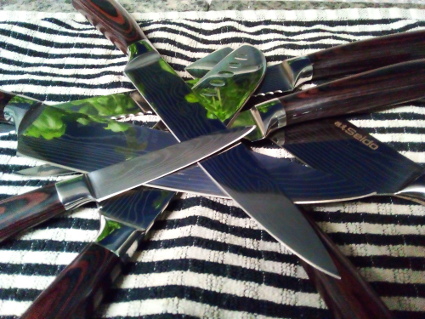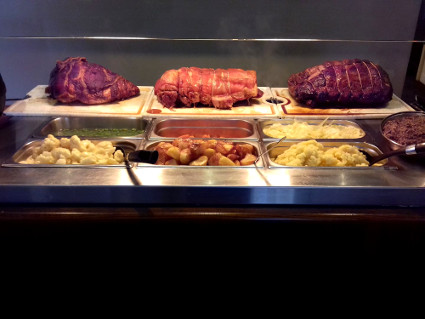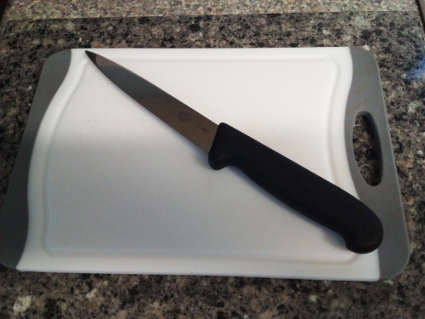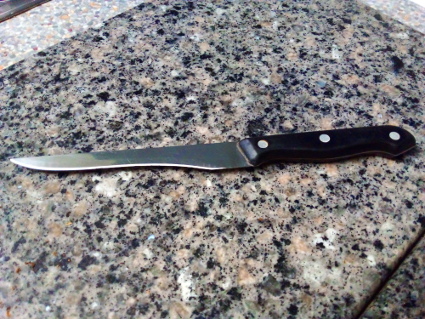
Odd Things you find in a clients kitchen.
I had a visit to regrind a few knives in the Bistopthorpe area of York today. Lovely lady with a Golden Labrador puppy and the biggest fluffiest older Cat I’ve see for a while. It’s not for me to judge others, but I do feel comfortable with folk who are nice to animals, pets or Foxes they are cool, you know?
Anyway the lady produced these knives and said that her son had been asking for them to be sharpened for a while…. Now I’m not a knife snob, honestly I’m not. But anybody who has ever set foot in a commercial kitchen knows what these are at first sight. Half a set of Global Knives.
The story behind these seems to be that they were just left in a drawer and found when the lady moved in. They’ve clearly had a hard life and probably been treated in ways a Chef would kill you for, in the past. But good knives are good knives.
I can’t grind the tips back on, miracles take more that a bloke and a grinder. But I was able to restore the very damaged edges to shaver sharp condition. They grind superbly and were as much a pleasure to work with as I’m sure they will be to cut with – now!!!!
Oh man they are so sharp!!!!!

It’s not always older loved knives which need re-grinding.
These superbly crafted knives had made quite a journey from Japan via America. The last leg of that journey from America to the UK took 3 months. Although the knives are of outstanding quality, well balanced and razor sharp, the packaging was unfortunately not to the same standards! One of the blades had been ‘Dinked’ in transit even though they had plastic protectors. The last 1mm of the tip was bent into a very small, but very noticeable hook. Softer Steel blades are much easier to maintain, but they do suffer badly with tip damage if they are treated inappropriately.
Returning them under warranty via the USA would have been costly and would probably have meant that the replacements would have taken over 3 months to arrive. So I reground the tip following the original blade profile but removing enough Steel to eradicate the tip hock.
The result was a sinisterly sharp blade with no visible signs of alteration. Pretty cool I think?

Before I start I should point out that as an ex-butcher this was a school boy error. Never trust others to do as you would expect yourself….
Some four years or so ago Sue and I moved into a Pub in Acomb, to run the kitchen. Sue has run kitchens for most of her working life. After giving the kitchen a deep clean we had several pretty good days service with plenty of covers and happy customers.
We’d been told that the Sunday Carvery was the main event so I’d been to the wholesalers for the Turkey Crown and vegetables. The Butcher had delivered the Beef and Pork. We’d spent all the time between service on the Saturday prepping veg etc. On the Saturday evening we retired reasonably early in the knowledge that we were good to go in the morning. Or so we thought…..
7am on the Sunday morning saw us firing up the oven and putting the first round of carvery joints in. Sue had the Yorkshire Pudding batter sorted and the first industrial pans full of veg were on the hob ready to boil. I initially had a few electrical issues with the carvery unit but soon had it heated and the plates in the hot hold. The doors were due to be opened at 12 noon and twenty minutes beforehand we had the carvery dressed. Home made gravy from the meats. Home made Yorkshires. A full complement of veg etc. I arranged the carving boards over T towels to stop them sliding around and put the carving knife, steel and fork to the side. A quick photograph to share on Social Media and the doors were duly opened. The arrangement was that folk buy a ticket from the bar and then help themselves from the carvery requesting which meat / meats they wanted from me, which were carved on request. How easy a well organized carvery can work….
As my first family formed an orderly cue I passed their heated plates to them and casually did the butcher thumb test on the knife. Hmmm I was clearly holding the largest Butter knife in Yorkshire! Try as I might using all my ex-butchers skills there was no way on earth that I was going to get that knife to carve anything harder than a boil Spud. Alarmed by my apparent lack of preparation and trust in the previous Chef I excused myself and scuttled back to the kitchen. In the draw I found quite a collecting of carving knives and it suddenly became hideously clear why they had been left behind!
I struggled through that first Sunday doing my best with the worst dinged, bent and dull blade I’d ever had the misfortune to have in my hand. Thankfully none of the dinners were telepathic as the language in my head was colourful to say the least.
It’s the time of year soon for Jurassic Chickens (Roast Turkey), Wilder Beast Rump (Roast Beef) and Wild Boar (Roast Pork)
Don’t get caught out like I did. It’s very embarrassing…... You know a chap who will be more than happy to pop round a re-grind your knives - https://www.sharpenyork.com/index.php/request-a-sharpen

When I was at school our caretaker was very protective of the hall floor. He banned high heals entirely. Pupils, parents, teachers, visitor – they were just not allowed. His reasoning was quite logical. The weight of a moderately slim human concentrated on a steel tipped narrow heal represent several tons per square inch of pressure and punched holes through the varnish and into the wood.
The same applies to your knives.
Although Granite worktops and Glass chopping boards look really good they are actually knife killers. When you slice through something which offers resistance the click you hear, the chopping noise if it like, is the microscopically thin cutting edge of your knife hitting the surface you are cutting on with considerable force. Something has to give and if the surface you are cutting on is harder than the edge on your knife - the surface wins and you’ve brutally damaged your knife!
When I worked in butchery we had the traditional Butchers Block and thick plastic topped cutting tables. In commercial kitchens the Environment Health Officers take a very dim view of wood, so Chefs Boards are plastic and usually colour coded.
In your home kitchen it really doesn’t matter if your prefer wood or plastic. As long as you protect your knives from hard surfaces they will stay sharper for much longer. Clearly your boards are going to become scored over time and will eventually need to be replaced. So environmentally wood is the better option. But replacing your boards after 6 months or more is going to be much less costly than having to replace your knives or repeatedly have them reground.

These older knives with the crazy shaped blades are hidden gems in hiding. Sometimes stronger isn’t better.
This is certainly the case we domestic kitchen knives. These old knives were your standard low cost kitchen blade a few decades ago. Often stamped with “Sheffield Steel” on one side of the blade they have a notable advantage compared to low priced knives made today. The Steel used for their blades was quite soft in comparison with the Stainless Steel we see so often now. Once reground this means that you can maintain a good edge at home with a drag sharpener or Steel, for considerably longer than you can with a Stainless blade. You also get to make the crazy shaped blade even more interesting over time!
We use Cookie Files to provide you with the best experience. These are short term files and do not collect any personal information.
